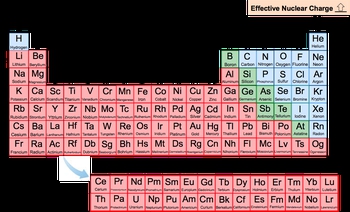Now here we're going to use Slater's rule to determine our new effective nuclear charge. Now Slater's rule is just a system used to determine the effective nuclear charge of a specific electron within an orbital. So we're given just more than the shell number for our electron. For this example, it says using Slater's rules, calculate the effective nuclear charge of a 3p orbital electron in calcium.
So step 1 is we're gonna group the electrons in an electron configuration in order of increasing n value and in this form. So calcium would be here on the periodic table, Its electron configuration would be 1s2, 2s2, 2p6, 3s23p6. We haven't gone to 3d with it so we skip 3d4s2. Here we've listed it in order in in order of increasing n value. So this would be 1 because 1 here, this would be n equals 2, n equals 3. 3d is also n equals 3, but 3 the s and p orbitals are similar because they're in the same row of the periodic table, so we group them together. 3d is its own separate row, and if we have f it would be its own separate thing as well.
Then we have 4s and 4p which are n equals 4, 4d is here separate from 4s and 4p, and then 4f is also separate because it's in its own row. This would be 5 and this would also be 5. Now this is important. We have to electron. So it's here, somewhere in here. We're asked to find the effective nuclear charge of a 3p electron. So it's here, somewhere in here. We're gonna use the lower electron groups to the left to determine the calculated shielding constant. Because remember, the electrons in front are the ones protecting that electron from the full blast of the nucleus. Ignore higher electron groups those to the right. They don't shield us.
So the electron we're looking at is this one. It's being shielded from the full effect of the nucleus by the electrons that are lower than it, these ones in orange. It's also being partially protected by the electrons in the same shield as it, the ones in yellow. Now we're gonna use the calculated shield constant of the electron to determine the effect of nuclear charge. So the calculated, shielding constant equals the electrons within your electron group times our our Slater's constant, plus adding up all of the lower electrons, the ones to the left of our electron, times their Slater's constant. Here, all of this will help us to calculate the shielding constant using Slater's rule.
Alright. So how does this work? Well, for s and p electrons we're gonna say electrons in the same group, their slayer's constant is equal to 0.35. If it's an n minus one group then each electron is 0.85, and if it's n minus 2 or greater then it's 1.0. For DNF, if they're in the same group, it would be 0.35, and then if it's lower than that, then we would say here that it is, point 85. Then here it's s count equals your atomic number minus your Slater's constant. So let's see how it would work.
Here n equals 1, here n equals 2, here n equals 3, and here n equals 4. We're looking at one of these electrons here. So let's say within there, there are a total of 8 electrons. Right? And we're looking at one of them. So that means there are 7 other electrons in my same group with me. Each one of them is 0.35, which comes out to 2.45. N minus 1, so one n value lower than me are these electrons here. And there are 8 of them total. Each of them contributes 0.85 when it's n minus 1. So that comes out to 6.80. Then finally, groups that are n minus 2 or greater which is this one here, this one has 2 electrons within it. So that's 2 times 1.00. The total value here we get is 8.0, 11 point sorry, 11.25.
So for calcium, we'd say that it's effective nuclear charge, which is s cal equals its atomic number, which on the periodic table is 20, minus what we just found here for our Slater's constant, 11.25. Plugging all that in means that we're gonna feel an effect of 8.75 as the effective nuclear charge for calcium. So this is what the calcium electron within the 3p electron orbital will feel in terms of the attractive pull of the nucleus. So it can be a little bit complicated, but this is the approach we have to take when they're giving us more specific information on an electron within a given orbital.



